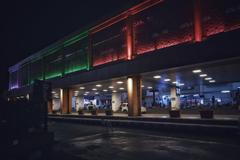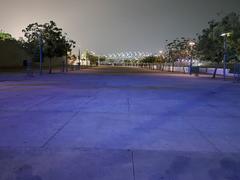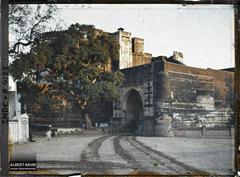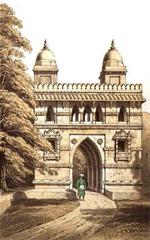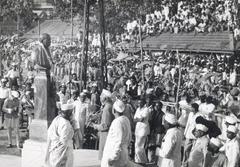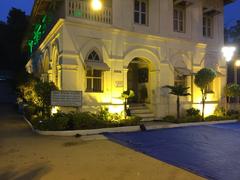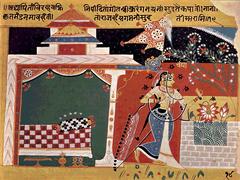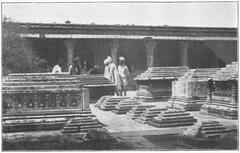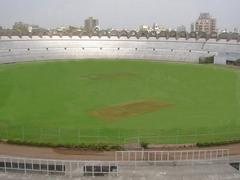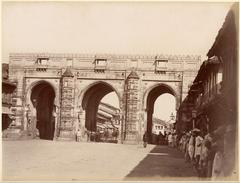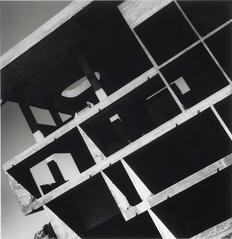
Manek Chowk Ahmedabad: Visiting Hours, Tickets, and Travel Guide
Date: 04/07/2025
Introduction
Manek Chowk, set in the heart of Ahmedabad’s historic walled city, is a vibrant square that epitomizes the city’s rich cultural tapestry, historic significance, and dynamic urban life. Named after the 15th-century saint Maneknath, who is said to have blessed the city’s foundation, Manek Chowk has evolved over centuries from a ceremonial and commercial hub during the Sultanate and Mughal eras to a bustling marketplace that undergoes three distinct transformations each day. Its strategic location near iconic landmarks such as Bhadra Fort, Teen Darwaza, and Jama Masjid, alongside its inclusion in Ahmedabad’s UNESCO World Heritage City designation, makes it a focal point for heritage enthusiasts, foodies, and everyday city life (Gujarat Expert; TravelSetu).
This comprehensive guide covers the history, visiting hours, market cycles, practical tips, nearby attractions, cultural highlights, and frequently asked questions to help you plan a memorable visit to Manek Chowk—Ahmedabad’s living heart of tradition and modernity.
Table of Contents
- Introduction
- History and Origins
- Evolution as a Commercial and Social Hub
- Architectural and Urban Significance
- Visiting Hours and Market Cycles
- Culinary and Cultural Experiences
- Nearby Attractions and Heritage Walks
- Practical Travel Tips
- Frequently Asked Questions (FAQs)
- Summary and Visitor Recommendations
- References
History and Origins
Founded soon after Ahmedabad’s establishment by Sultan Ahmed Shah in 1411 CE, Manek Chowk was named after Saint Maneknath, who played a key role in the city’s foundation. Originally, it was a central open space within the fortified city, close to Bhadra Fort and the royal precincts. Over the centuries, it became a hub for civic, commercial, and ceremonial gatherings, reflecting the urban planning of medieval Islamic cities (Gujarat Expert).
Evolution as a Commercial and Social Hub
During the Sultanate and Mughal periods, Manek Chowk blossomed into a thriving center of trade and community life. By the 16th and 17th centuries, it was the nucleus of Ahmedabad’s mercantile activity, hosting markets for grains, spices, textiles, and precious metals. Its location at the intersection of trade routes enabled exchanges among local artisans, traders from across India, and international merchants from Persia and Central Asia.
The square is also surrounded by pols (traditional housing clusters) and havelis, fostering a vibrant community atmosphere. In the colonial era, Manek Chowk adapted to new regulations and became renowned for its jewelry market—a reputation it retains today (TravelSetu).
Architectural and Urban Significance
Manek Chowk is framed by significant architectural landmarks:
- Bhadra Fort: The original citadel of Ahmedabad, to the west of the square.
- Teen Darwaza: A grand triple-arched gateway, the ceremonial entrance built in 1415 CE.
- Maneknath Temple: Honoring the saint after whom the chowk is named.
- Jama Masjid: One of the largest mosques in Ahmedabad, located a short walk away.
These structures exemplify Ahmedabad’s syncretic Indo-Islamic heritage and its pluralistic traditions, with Hindu, Jain, and Muslim influences visible in the area’s architecture, festivals, and daily life (Buoyant Lifestyles).
Visiting Hours and Market Cycles
Manek Chowk is unique in its daily transformation:
- Morning (6:00 AM – 11:00 AM): Fresh produce and vegetable market. Vendors offer a lively array of fruits, greens, and spices, attracting locals and early risers (Thrillophilia).
- Afternoon (12:00 PM – 5:00 PM): Bullion and jewelry market. The Sarafa Bazaar comes alive with traders dealing in gold, silver, gemstones, and traditional jewelry (MagicBricks).
- Evening/Night (8:00 PM – 1:00 AM): Street food bazaar. After sunset, the square becomes Ahmedabad’s premier street food destination, with stalls offering everything from pav bhaji and bhajiya to kulfi and chocolate sandwiches (Delhi Fun Dos; Knocksense).
There is no entry fee to visit Manek Chowk, and it is accessible round the clock, though market timings are as above (Holidify).
Culinary and Cultural Experiences
Street Food Culture
Manek Chowk is celebrated for its vibrant night food market. From 8:00 PM onwards, the square is filled with the aromas of Gujarati and Indian street foods, including:
- Pav Bhaji
- Bhajiya
- Cheese Dhokla
- Chocolate Sandwiches
- Kulfi (traditional Indian ice cream)
- Jalebi, fafda, and more
Dining here is a social ritual, with people from all walks of life gathering to enjoy affordable, delicious food in a lively, communal atmosphere (Tribecca Agora Mall).
Festivals and Community Life
Manek Chowk is a venue for major cultural festivals such as the International Kite Festival (Uttarayan), Navratri, and religious processions. It also hosts an annual puja and flag-hoisting at Manek Burj, celebrating the saint Maneknath’s legacy (Gujarat Tourism).
The square remains a space for civic engagement, public meetings, and social innovation, reflecting Ahmedabad’s pluralistic ethos (Explore City Life).
Nearby Attractions and Heritage Walks
Manek Chowk is within walking distance of several historic and cultural sites:
- Bhadra Fort: Explore the fort’s architecture and urban legends.
- Teen Darwaza: Marvel at the grand gateway’s intricate design.
- Jama Masjid: Visit this 15th-century mosque, a marvel of Indo-Islamic architecture.
- Rani no Hajiro and Badshah no Hajiro: Discover royal tombs and bustling markets for jewelry, textiles, and perfumes (Gujarat Tourism).
- Heritage Pols: Wander through traditional housing clusters for a glimpse of local life.
Heritage walks, starting from Manek Chowk, are popular and offer guided exploration of the city’s architectural and cultural treasures (Ahmedabad Heritage Walk).
Practical Travel Tips
- Best Time to Visit: Mornings for produce markets, afternoons for jewelry shopping, evenings for street food.
- Accessibility: Located centrally, Manek Chowk is reachable by bus, auto-rickshaw, taxi, and metro (nearest stations: Shreyas, Gheekanta, Shahpur). Parking is limited; public transport is recommended.
- Cash and Payments: While some vendors accept digital payments, it’s best to carry cash.
- Hygiene and Safety: Choose busy food stalls for better hygiene. The area is generally safe, but remain vigilant against pickpocketing.
- Mobility: The area is pedestrian-friendly but can be crowded. Narrow lanes may pose challenges for those with mobility issues; inquire about wheelchair-accessible tours if needed.
- Photography: The morning and night markets offer vibrant photo opportunities. Always ask permission before photographing individuals.
Frequently Asked Questions (FAQs)
Q: What are Manek Chowk’s visiting hours?
A: The square is open 24/7. The vegetable market runs from 6:00–11:00 AM, the bullion market from 12:00–5:00 PM, and the night food market from 8:00 PM–1:00 AM.
Q: Is there an entry fee?
A: No, entry is free for all visitors.
Q: Are guided tours available?
A: Yes, several operators offer guided heritage and food walks. Booking in advance is suggested.
Q: Are there special events or festivals at Manek Chowk?
A: Yes, major festivals and public events are held here. Check local tourism resources for schedules.
Q: Is Manek Chowk accessible for people with disabilities?
A: The area is generally accessible, though narrow, crowded lanes can be challenging at peak times.
Q: What are must-try street foods at Manek Chowk?
A: Pav Bhaji, Bhajiya, Cheese Dhokla, Chocolate Sandwich, and Kulfi are local favorites.
Summary and Visitor Recommendations
Manek Chowk is a microcosm of Ahmedabad’s layered history, cultural diversity, and commercial vitality. Its daily evolution—from an early morning vegetable market to a glittering afternoon bullion hub and a bustling night food bazaar—offers a rich sensory experience for all visitors. The square’s proximity to historical landmarks, vibrant community life, and ongoing heritage preservation efforts make it a must-visit for anyone exploring Ahmedabad.
To maximize your experience:
- Time your visit according to the market or activity that interests you most.
- Explore nearby historical and cultural sites.
- Embrace the local culinary scene, and consider joining a guided heritage or food tour.
- Capture the square’s vibrancy through photography and share your experiences.
- For the latest updates, guided tour bookings, and travel insights, download the Audiala app and follow us on social media.
References
- Gujarat Expert
- TravelSetu
- Buoyant Lifestyles
- Holidify
- Moneycontrol
- Tribecca Agora Mall
- Gujarat Tourism
- Knocksense
- Delhi Fun Dos
- Ahmedabad Heritage Walk
- MagicBricks
- Thrillophilia
- Explore City Life




